Summer. Time for barbecues, pool days, and flying roaches?
That’s right; summer is the season these flying critters are most prevalent.
Crawling cockroaches are creepy enough.
But when they start flying, they become a total nightmare.
The good news is, there are easy ways you can get rid of these pests.
And in this article, we’ll go over them in detail.
Let’s dive in.
How to Get Rid of Indoor Flying Roaches?
1. Place Sticky Traps Around Your House
Before you can eliminate flying roaches, you must first identify what type of cockroach you have.
Different types of cockroach behave differently and thus should be handled separately.
You wouldn’t want to treat an indoor flying roach the same way as an outdoor roach.
And just because you saw a roach indoors, it doesn’t mean they are indoors.
Some outdoor roaches can stumble indoors for various reasons.
So how do you tell them apart?
The best way to identify the type of cockroach in your home is by using a sticky trap.
Sticky traps catch everything that walks over it.
Once the cockroach is trapped, you’ll be able to get a good look at it.
Place these traps where cockroaches generally travel and live.
All roaches love food and water, so your first target area should be in your kitchen, bathroom trash bins, near drainage and mulch.
Some other great places to put the traps are in your basement, attic, and near indoor plants.
To make it much easier to capture roaches, place a bait such as a peanut butter on top of your sticky trap.
Check your traps to get a better look at what cockroach you have.
You can also use sticky traps to identify the severity of infestation you have.
If your trap only has a few cockroaches with about the same size, your infestation is likely small and early.
On the other hand, if your sticky trap has many roaches with different sizes (adults, various sized nymphs, etc.), chances are your infestation has grown.
It may take a few days to get a good sample if you’re dealing with smaller infestations.
But, if you have a significant infestation, you’ll typically only need one day.
The two flying indoor roaches are:
- American cockroach
- Brown-banded cockroach
American Cockroach
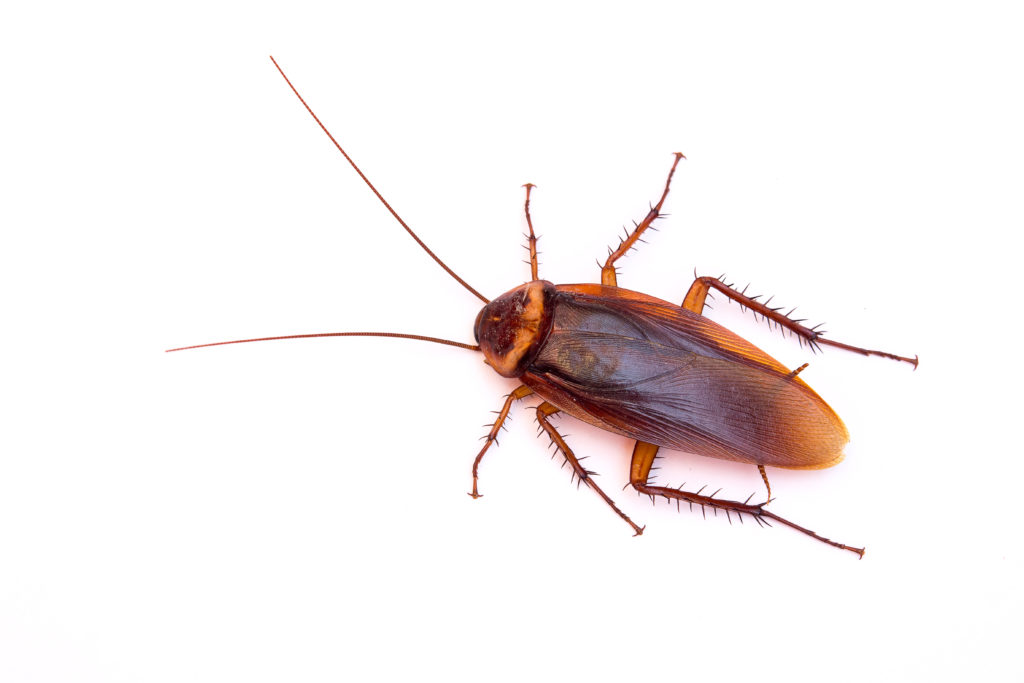
The American roach is the largest of all household roaches at 1.5 inches.
It has a reddish-brown color and well-developed wings.
They have a light band around their heads.
Male American cockroaches have wings longer than their female counterparts.
Males also have narrower bodies than females.
Brown banded cockroach
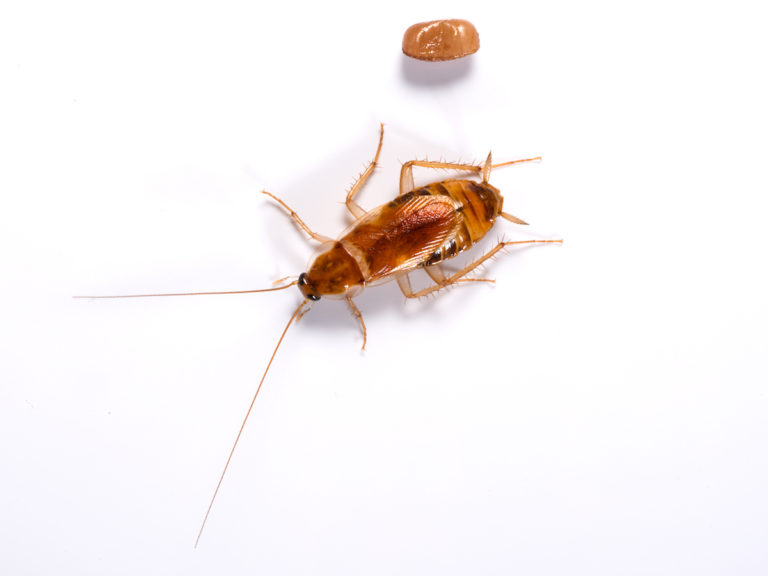
Adult brown-banded cockroaches grow to about ½” long.
An adult male brown-banded cockroaches have wings that stretch to the end of their abdomens.
These fully developed wings allow them to fly.
Females, on the other hand, have little wings and cannot fly.
Adult males typically crawl, but they will fly when they are disturbed.
2. Identify Where the Roaches You Have Live and Travel
American Cockroach
American cockroaches are one of the most common cockroaches that fly.
But, you’re more likely to see them crawling.
Often, when they fly, it’s because the temperatures around them are above 85 degrees, and they are trying to get away.
You can find them both indoors and outdoors.
More specifically, they love to stay in damp, dark places such as sewers and septic systems.
You’ll also find them staying in places where there’s easy access to food and water, such as bathrooms and kitchens.
Here are a several places to look:
- Under your kitchen and bathroom sink.
- Behind, under, and on the side of appliances.
- On the bottom of your kitchen countertops.
- On top of cabinets and shelves.
- Baseboards and crevices at the bottom of the cabinets.
- At the bottom and corners of kitchen cabinets.
- Near trash or inside trash cans.
- Near water sources such as pipes or hoses.
- Sewer lines
- Garbage disposals.
- Inside your pipes, sinks, showers. Check these especially if you have not used them for an extended period. Roaches tend to crawl inside them when the water evaporates.
Brown Banded Cockroach
These cockroaches love to be in warm, dry places.
You can typically find them in higher locations than most other cockroach species, taking shelter in upper cabinets in kitchens and bathrooms, as well as congregating near ceilings.
Also found near light fixtures, on crown molding, and electronics.
They also like to hide in small crevices in between cabinets, floorboards, and under appliances.
These places give them easy access to food, warmth, and water.
3. Apply Gel Bait to High Traffic Areas
Gel bait is one of the most effective ways to eliminate cockroach infestations.
This control method is highly effective because it implements tertiary kills.
Here’s what I mean.
Gel baits turn cockroach feces into poison.
When a cockroach ingests gel bait, they don’t die right away.
Because juvenile roaches (nymphs) rely on feces to survive, the toxic wastes will kill them.
Once they die, other cockroaches that eat their bodies become poisoned too.
Gel Baits can take one of two forms:
- Bait Stations
- Syringe or Tube Applicators
Bait stations are small stations where roaches can go and retrieve the gel bait.
Places get the bait to high-traffic areas and where the roaches live.
To cover all your bases, use a syringe applicator in together with the gel bait station.
Gel bait stations don’t fit in tiny holes and crevices where roaches travel.
To get around this, use a syringe applicator.
Apply it to small crevices and holes on your walls and floors to ensure that you capture as many roaches as possible.
Apply a pea-sized drop of gel bait about every two feet.
Doing so will allow the roaches easy access to the bait.
Gel bait is only effective for two weeks, so reapply accordingly.
To keep track of where you place your gel bait, place it on a 2×2 inch wax paper.
The wax paper wrap will also make it easy to put bait in hard-to-treat places (e.g., within stacks of clutter).
After two weeks, wipe down or remove the wax paper and apply some more.
4. Use Dust Bait in Small Crevices
Dust baits are similar to gel bait, except they come in the form of powder.
Use it in conjunction with gel bait to access smaller crevices that are hard to reach with gel bait.
It’s also good to place them in large areas to kill roaches that do not eat your gel bait.
Dust bait kills roaches via ingestion.
When roaches walk over the dust, it will get all over their bodies.
Because roaches regularly groom themselves by running their antennae and legs through their mouth, they will consume dust bait and die.
When using dust bait, remember to apply only a thin layer so the roaches won’t avoid it.
In most cases, one to two pumps is sufficient.
When roaches walk over the dust, it will get all over their bodies.
Since roaches groom themselves frequently, they will eat the dust and die.
The best place to apply dust bait include:
- Wall Voids
- Holes on Walls
- Crevices Between Cabinets and Appliances
- Under and Inside baseboard for Cabinet
- On top of cabinets
- On top of high furniture such as shelves or hutches
5. Seal All Entry points
Seal all entry points to prevent roaches from crawling back inside your home.
Here are some things you can do.
- Weatherstrip your doors and windows to seal gaps.
- Use a door sweep to block the gap under your door to prevent roaches from crawling in.
- I recommend using the kind that sticks onto the door with an adhesive strip, so you won’t need to drill.
- Seal the joint where your door frame meets the wall using a caulk.
- Check for holes and tears on your door and window screens and repair them.
- Seal any cracks from faucets and pipes so cockroaches can’t slip through.
- Check for any crevices and holes in the walls, doors, or windows.
6. Apply an External Barrier Using Insecticide
Keep these pests from getting back into your house by applying for external protection.
Use an outdoor insecticide and apply it around your house.
The insecticide will repel and kill any pest that goes over it.
Apply it to 3 feet of your house’s surface and 3 feet wide on the floor around your home.
Do this around your entire house.
The insecticide will typically last for 4-6 months, so re-apply accordingly.
Don’t forget this last step once you have eliminated your cockroaches.
It’s much better to prevent cockroaches from getting in than having to eliminate them again once they are in your home.
7. Insect Growth Regulators IGR’s)
Not all cockroaches eat the same food.
Pregnant females and nymphs depend on the feces from other adult roaches.
To cover all your bases, use IGRs in conjunction with all the treatments mentioned above.
IGR’s are like “birth control” for roaches.
It stops infestations by making adult roaches unable to reproduce.
It also blocks the roaches’ ability to turn into an adult.
If juvenile roaches are unable to grow into reproductive adults, their population will eventually die.
I recommend using IGR packets instead of sprays for ease of use.
Break the pack to activate the hormone and place them in the kitchen or bathroom.
For most, one IGR packet treats 50-75 square feet and lasts about three months.
So, apply and replace them accordingly.
Don’t skip on replenishing your packets. Doing so is essential to prevent stragglers from repopulating.
Also, keep in mind that IGR’s take time to take work.
Don’t expect your infestation to shrink overnight.
It takes over 1-2 months for nymphs to molt and grow, so use the packets for at least 7-8 months.
Reapply IGRs 2-3 times to eliminate your infestation.
How to Get Rid of Outdoor Flying Roaches
1. Place Sticky Traps Around Your House
Like treating indoor roaches, the first step to getting rid of outdoor cockroaches is to be sure what roach species you are dealing with.
If you think you saw an outdoor roach in your home, I recommend starting with a sticky trap in places where roaches tend to live and travel.
Outdoor roaches thrive on decomposing materials so it’s best to start with your kitchen.
Some other place you can place your sticky traps are in your attic and basement.
Outside, you’ll want to place these traps in your graden shed, outdoor storage units and near trash bins.
Some other place to check are woodpiles, rotting leaves, mulch, and piles of leaves.
And the outdoor flying roaches are:
- Wood Cockroach
- Australian Cockroach
- Smokey Brown Cockroach
- Asian Cockroach
Wood Cockroach
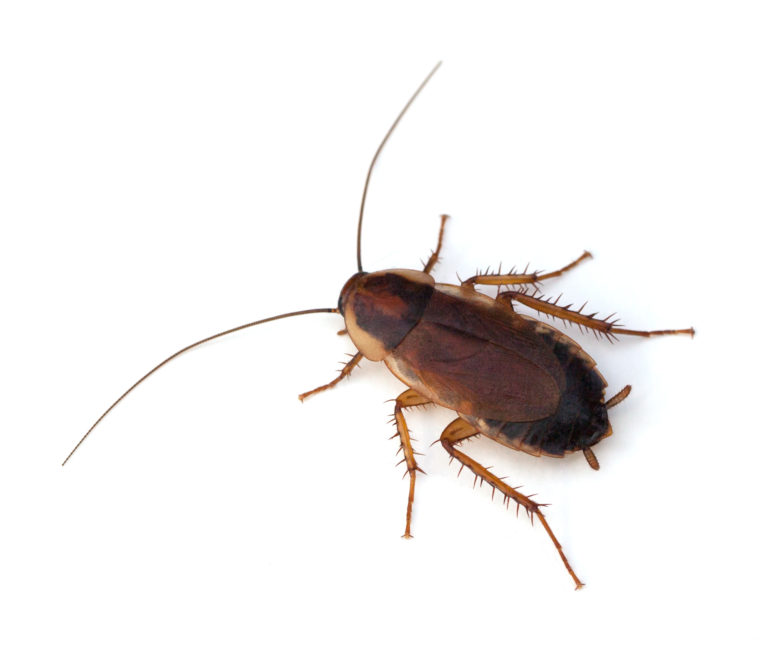
Wood Roaches look very similar to American cockroaches in terms of size and color.
Adult wood roaches grow to be round ¾ inch to 1 inch.
They have a flat, oval-shaped body, with one solid light to dark brown color.
Their antennae are long, and their legs are spiny.
Female Wood roaches don’t have wings.
Adult males on the other hand have wings and are capable fying.
Australian Cockroach
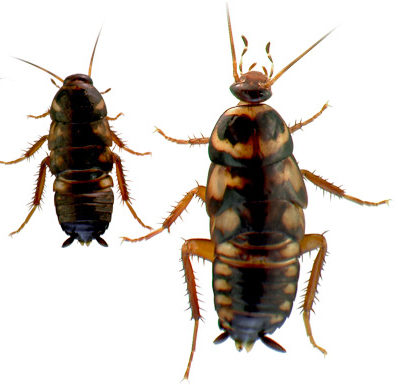
This species looks like an American cockroach.
Their bodies grow to about 1 and 1/4 inches long with colors ranging from reddish-brown to dark-brown.
They have fully developed and functional wings.
One thing that distinguishes them from the American cockroach is the yellow bands on the upper side of their wings.
Smokey Brown Cockroach
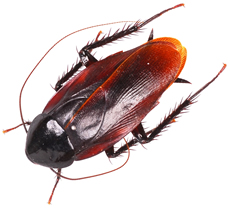
The Smokey Brown Roaches are dark in color.
They have long wings, extending past their bodies, which are around 1.5 inches long.
If you are unsure if a roach in your home is a Smokey Brown Roach, check the coloring.
Smoky Brown cockroaches have a dark brown, almost black solid color across their bodies.
Asian Cockroach
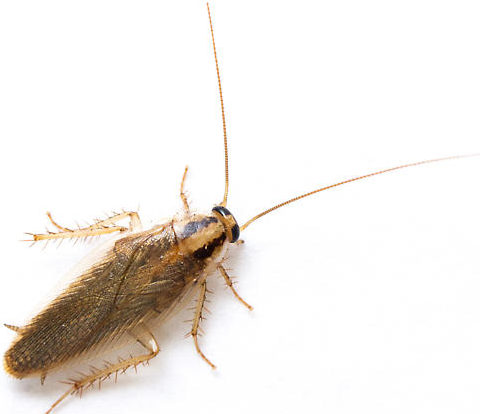
Asian cockroaches look nearly identical to German roaches.
They might look just like their German relatives but their behavior is on the opposite side of the spectrum.
The Asian cockroach is an outdoor species that most commonly live in shaded areas
They especially like living in mulch and grass, where their numbers can rise into the thousands very quickly.
They’ll also infest compost piles and feed on the organic material inside.
Most often they enter homes by accident through open doors, windows, and poorly fitted seals.
Asian cockroaches are strong fliers and they prefer to live outside.outside.
Attracted to light, they may fly towards bright entryways and porch lights.
2. Identify Where the Roaches You Have Live and Travel
Wood Cockroach
Wood roaches live and breed outdoors.
Wood cockroaches are drawn to light, so they are likely to stumble in your home at night.
Sometimes they will accidentally hitch a ride into your home on firewood stored outside.
Wood roaches are attracted to light and decaying organic materials.
They love woodpiles, rotting leaves, and still water.
They also love to be in mulch, piles of leaves, and near flower beds.
When they enter your home, they will gravitate towards decaying organic materials.
They will also go towards sweet and starchy foods, so you’ll likely see them on trash bins.
They also like to be inside sheds, outdoor storage units, and anywhere near water sources such as water boilers or water hoses.
If you have wood shingles around your home, you can also check there.
Finally, wood roaches eat rotting organic matter, so check any place for them.
Australian Cockroach
The Australian cockroach lives mostly outdoors but can sometimes stumble indoors.
They are the most common cockroach species found outdoors in southern Florida.
Australian cockroaches will go indoors in search of warmth, food, and water.
They feed on plant material and decomposing materials.
Smokey Brown Cockroach
These critters live outdoors.
They like warmth, light, and water.
As such, you’ll typically find them hanging out in planter boxes, shingles, woodpiles, shrubs, trees, and other vegetation.
Although rare, it’s also possible to see these roaches in your home, particularly in attics, garages, and basements.
They typically enter your home by accident and do so when chasing the light.
In some cases, they go indoors looking for a source of water.
Asian Cockroach
Asians prefer to live in shaded areas outside.
They especially like living and breeding in mulch and grass.
They’ll also feed on the organic material inside compost piles.
While these pests live outdoors,
they can enter homes by accident through open doors, windows, and poorly fitted seals.
They are attracted to light and tend to fly towards bright entryways and porch lights at night.
3. Seal All Entry Points
Outdoor flying cockroaches are considered “accidental” pests.
That is because they wander into your home by accident.
These roaches either cannot or will prefer not to breed indoors.
If you see an outdoor roach inside your home, you’re likely dealing with an infestation outside.
It is also likely that you have easy entry points around your home.
So, the best way to get these roaches out of your home is by sealing them out.
Make sure your window and door screens don’t have any holes and tears.
Don’t leave your windows and doors ajar. If you like keeping them open, make sure you have screens installed.
Weatherstrip your doors and windows to keep wood roaches from entering the sides or top of your door.
Use a door sweep to block the gap under your doors to prevent wood roaches from crawling in.
If you don’t want to drill, you can use a door strip that sticks onto the door with an adhesive strip.
This way, you won’t need to use a drill.
Seal the joint where your door frame meets the wall using caulk to prevent any roaches from sliding in through small cracks.
Make sure your faucets and pipes don’t have any cracks where cockroaches can slip through.
Finally, do a quick inspection around your home and seal up and holes or cracks.
An easy way to do this is by applying caulk.
Cockroaches can fit through small cracks or holes, so cover up even those you think they won’t fit in.
Any roach that is inside your house won’t be able to reproduce and will eventually die.
If you do not want to wait until then, you can use sticky traps to capture them.
4. Use Insecticide Outdoors
The finish, spray a perimeter treatment around your home.
Spray around doors and windows, around the foundation going up 2 or 3 feet.
Also, spray any other possible points of entry.
These sprays typically last three months, so reapply accordingly.
If you have a garden or pets, I recommend using natural pesticides such as diatomaceous earth to keep cockroaches out.
For this, I recommend mixing diatomaceous earth with water for easier outdoor applications.
In a spray bottle, mix ½ cup DE (8 tablespoons) and 2 cups of water.
Spray the formula throughout your yard.
While DE doesn’t work when wet, it will once the formula has dried up.
Another natural insecticide you can use in your garden is cinnamon.
Place a thin layer of cinnamon to your garden soil to repel, including cockroaches.
You’ll also want to apply a barrier around your yard and to keep roaches away.
Frequently Asked Questions (FAQ)
Why Do Cockroaches Fly Towards You?
Most indoor cockroaches shy away from humans and will not fly towards you.
If an indoor roach flies straight towards you, it’s because they cannot control where they’re headed.
In contrast, if an outdoor roach flies towards you, it’s more likely that they are flying towards what’s around you.
Outdoor roaches are attracted to light, and if you are holding your phone or standing near a television, they will be drawn to you.
Can Cockroaches Climb?
Yes, cockroaches are great climbers.
Flying cockroaches, in particular, can use their wings for additional help.
If they can’t crawl up a surface, they will fly instead or use their wings to do a fluttered jump.
Do Water Bugs Fly?
Waterbugs fly.
But they are not cockroaches.
They are often confused with roaches, however, because of their similar colors and body shape.
Here is a guide to help you distinguish between animals that look like cockroaches and cockroaches themselves.
Do All Cockroaches Have Wings?
No, not all cockroaches have wings.
Some cockroaches don’t have wings.
Some do but can fly, such as German cockroaches.
And some still can fly and will fly like American, Brown-banded, Asian, Australian, Oriental, and Wood cockroaches.
Outdoor cockroaches such as the Asian, Australian, Oriental, and Wood cockroaches are more active flyers than most indoor cockroaches.
Flying bug that looks like a roach?
June bugs, beetles, crickets, waterbugs, and termites can all fly and look like cockroaches.
Do Cockroaches Jump?
Yes.
The American and Brown-banded cockroaches, in particular, use their wings to flutter or jump rather than to fly.
Cockroaches will jump when threatened.
They will also sometimes jump to reach certain areas if they can’t do so by crawling.
Why Do Cockroaches Fly?
Cockroaches typically fly when threatened and to reach the locations they want to go to.
They commonly fly to reach cooler temperatures when the weather is hot.
Outdoor roaches typically fly to be closer to light.
Can Palmetto Bugs Fly?
Yes, palmetto bugs can fly.
Palmetto bug is a nickname given to American and Asian cockroaches that typically hide near palmetto bugs.
Both roaches have wings and can fly.
Are Flying Cockroaches Dangerous?
While cockroaches don’t bite humans, they are dangerous because they carry dieaseas and bacteria into your house.
American cockroaches and brown-banded cockroaches are especially dangerous because they live in sewers.
And since they live indoors, they can quickly spread disease-carrying bacteria to your food and cooking surfaces.
What Type of Flying Cockroach Is In The Philippines?
The most common type of flying cockroach to infest the Philippines is the American cockroach.
Brown banded cockroaches are also common in the Philippines.
Based on video evidence the more common flying cockroach is over 1 inch suggesting that they are American cockroaches.
What Type of Flying Cockroach Lives In Texas?
If you see a flying cockroach in Texas, it is likely a Wood cockroach or Asian cockroach.
Can Pennsylvania Wood Cockroaches Fly?
The Pennsylvania Wood cockroach can fly.
They are the same species as a Wood cockroach but given a unique name because of how prevalent they are in Pennsylvania.
When Are Flying Cockroaches More Prominent?
It’s far more common to see cockroaches flying during the summer months.
Cockroaches are cold-blooded, which means they get more active when the temperature rises.
When the weather gets hot enough, they prefer to fly than craw towards cooler locations to save energy.

1 thought on “How To Get Rid of Flying Cockroaches”